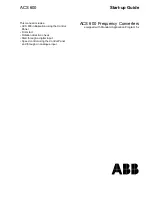
HHD264
10
© Copyright 2016 Hall Research, Inc.
BAUD:
Dip-switch positions define a 3 bit binary number. When it is held UP, it
is “0” and when held down, its value is “1”. So there are a total of eight
combinations and each denote a baud rate in bits per second (bps) as below
000 = 2400 (default)
001 = 4800
010 = 9600
011 = 19200
100 = 28800
101 = 38400
110 = 57600
111 = 115200
MULTICAST GROUP:
The 6 position dip switch is used to assign the group
number (channel number) video is cast on the network. Similar to the baud Dip-
switch, it is set from left (least significant bit) to right (most significant bit).
Again, if you use the Windows™ GUI tool you will have a graphical image of the
dip switch making it easy to set.
RESET:
This button has two uses. Press it momentarily to cause a reboot (same
as power cycle). Press and hold for 10 seconds to restore factory defaults.
Figure 4.3 - DIP-Switch example
NOTE
The DIP setting order is from right to left. As shown in the example above.
The Windows™ GUI gives you graphical image of the dip switch making it
easy to set the switch.
NOTE
You have the option to completely ignore the dip-switches!
As mentioned earlier both Baud Rate and MultiCast Group/Channel number
can be set in both WebGUI of each unit or the Windows™ tool. So why have
dip switches at all?
By default when units are powered up the devices revert to the dip-switch
positions. This may be useful in certain situations. For example: if there is a
power interruption or outage in the building you can make sure the system
comes up in a known state every time (as determined by the dip-switches).
Having dip-switches also speeds up installation of a simple, static system
without worrying about IP configuration. Just set the dip-switches to pair
Receivers & Senders and you are done.
There is a setting in the WebGUI of each device to ignore the dip-switches
on power up and recall the previous setting from memory.
When this option is selected, the dip-switches perform no function whatsoever!










































